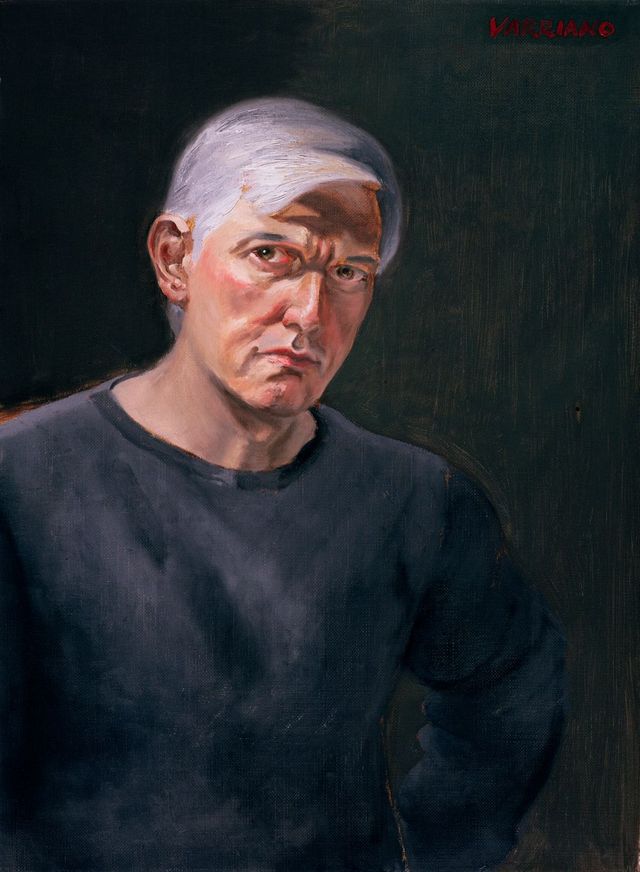Discover the very best Tips for Creating Stunning Figurative Oil Painting Artwork
Discover the very best Tips for Creating Stunning Figurative Oil Painting Artwork
Blog Article
The Function of Feeling and Expression in Figurative Oil Painting: A Comprehensive Analysis of Subject and Composition
The interplay of feeling and expression in figurative oil painting offers as an important lens via which one can examine the complex relationship in between subject matter and composition. Artists harness different strategies, from color option to brushstroke dynamics, to cultivate emotional vibration within their jobs.
Understanding Emotion in Art
Feeling in art offers as an effective channel for expression, allowing musicians to convey complicated feelings via their work. In figurative oil paint, this emotional deepness is often represented through the depiction of the human number, recording the subtleties of human experience. The choice of subject issue, color palette, and brushwork all add to the emotional vibration of a piece.
Artists regularly bring into play personal experiences, social concerns, or global motifs to evoke feelings in the viewer. A portrait might mirror susceptability, while a dynamic figure in movement can represent liberty or chaos. These emotional threads link the audience to the art work, promoting a dialogue that transcends the aesthetic medium.
In addition, the interaction between light and darkness can magnify emotional strength, directing the audience's gaze and attracting interest to specific elements within the make-up. Making use of appearance in oil painting better includes layers of intricacy, inviting a responsive feedback that boosts the psychological experience. Generally, comprehending feeling in art is essential for appreciating the subtleties that identify figurative oil painting, as it changes plain depiction into an extensive expedition of the human condition.
Crucial Element of Composition
In the realm of metaphorical oil painting, the structure functions as the underlying structure that arranges aesthetic components and boosts the emotional narrative. Necessary parts of structure consist of balance, contrast, centerpiece, and rhythm, each contributing to the overall effect of the art work.
Balance describes the circulation of aesthetic weight within the paint, which can be achieved via unbalanced or balanced setups. A healthy structure offers security, allowing the visitor to involve with the item sympathetically - figurative oil painting. Comparison, on the various other hand, includes comparing various aspects, such as light and dark or warm and trendy shades, to lead the viewer's eye and stimulate psychological feedbacks
The centerpiece is critical, as it routes interest to the most considerable component of the paint, usually highlighting the psychological core of the narrative. Via strategies like color saturation or positioning, musicians can stress this location efficiently. Rhythm pertains to the repetition of components, creating a sense of motion and flow throughout the composition. By masterfully incorporating these vital aspects, musicians can craft engaging and emotionally resonant figurative oil paintings that mesmerize and engage their target market.
Topic and Its Impact
Topic plays a pivotal function in figurative oil painting, as it not only offers as the structure for the narrative however additionally shapes the visitor's interpretation and emotional interaction with the artwork. The selection of subject-- be it a singular figure, a group dynamic, or a thematic depiction-- directly influences the psychological environment shared to the audience.

For instance, portraits often stimulate personal links, exposing the intricacies of human expression and character, while scenes showing common activities browse around here can create a sense of belonging or fond memories. In addition, the historical and cultural context of the topic enriches the visitor's understanding, motivating much deeper representations on societal standards, worths, and the human condition.
Various subjects additionally produce varying levels of engagement; a dramatic problem portrayed via numbers in stress may generate sensations of stress and anxiety or empathy, while serene landscapes can invoke serenity and reflection. Eventually, the impact of subject issue in figurative oil painting is profound, as it functions as a channel for emotional vibration, guiding the viewer's reference feedback and analysis, and promoting a connection in between the art work and the viewer. This interplay is essential for the successful interaction of the artist's intent.
Strategies for Evoking Sensations
The efficiency of metaphorical oil painting in communicating feelings is considerably influenced by the strategies utilized by the artist. One of one of the most essential techniques is using color theory, where the critical selection of colors can evoke specific emotional responses. Warm colors, such as oranges and reds, usually generate sensations of interest or hostility, while cooler tones like blues and environment-friendlies often tend to stimulate peace or despair.
An additional crucial strategy is the control of light and shadow, called chiaroscuro. This technique boosts the three-dimensionality of figures, developing dramatic contrasts that can increase psychological deepness. The positioning of light can assist visitors' emotions, highlighting particular components of the make-up.
Brushwork also plays an important duty; loose, expressive strokes can communicate energy and spontaneity, whereas smoother methods might recommend harmony or precision. Moreover, the arrangement of subjects within the structure can affect emotional effect. Close distance can suggest affection, while distance may indicate isolation.
Ultimately, the combination of these techniques enables artists to craft stories that reverberate with the customer, changing a simple aesthetic experience right into an evocative emotional journey. - figurative oil painting

Study of Remarkable Functions
Examining noteworthy jobs of figurative oil paint reveals just how numerous strategies are employed to evoke powerful feelings. One exemplary instance is Edvard Munch's "The Scream," where the altered figure and swirling history share existential dread. Munch's use shade-- deep blues and vibrant oranges-- intensifies the psychological impact, showcasing just how combination choices can form viewer experience.
One more considerable work is Pablo Picasso's "Les Demoiselles d'Avignon." Right here, vibrant brushstrokes and fragmented types reflect a turbulent emotional landscape, challenging conventional representations of the female number. Picasso's ingenious composition not only records the audience's interest however likewise welcomes contemplation on Check This Out themes of identity and sexuality.
Additionally, Frida Kahlo's "Both Fridas" offers an emotional exploration of duality and self-identity. The different figures, linked by a shared heart, exhibit Kahlo's emotional depth and individual narrative. figurative oil painting. Her thorough focus to detail and symbolic elements offer to engage customers on a natural level
These study highlight the extensive connection between emotion and make-up in metaphorical oil painting, exposing just how musicians harness technique to communicate intricate sensations and stories that reverberate throughout time and culture.

Final Thought
To conclude, the interplay of emotion and expression in metaphorical oil painting considerably enhances the visitor's experience and interpretation of the artwork. Through a careful option of topic and compositional methods, artists convey profound narratives that reverberate on both individual and universal degrees. The application of shade theory, brushwork, and chiaroscuro more amplifies emotional depth, transforming each canvas right into a powerful reflection of the complexities of the human experience.
In metaphorical oil painting, this emotional deepness is frequently depicted with the depiction of the human figure, catching the subtleties of human experience.Moreover, the interplay in between light and shadow can enhance psychological intensity, leading the visitor's stare and drawing attention to certain aspects within the make-up. The use of appearance in oil paint even more includes layers of intricacy, inviting a tactile feedback that enhances the emotional experience.The focal factor is critical, as it directs focus to the most substantial part of the paint, commonly highlighting the psychological core of the narrative. Inevitably, the impact of subject issue in figurative oil painting is extensive, as it serves as a channel for psychological resonance, assisting the viewer's reaction and analysis, and fostering a connection between the art work and the viewer.
Report this page